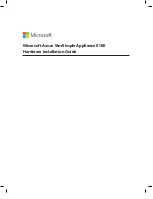
•
If a switch running VTP version 3 is connected to a switch running VTP version 1, the VTP version 1
switch moves to VTP version 2, and the VTP version 3 switch sends scaled-down versions of the VTP
packets so that the VTP version 2 switch can update its database.
•
A switch running VTP version 3 cannot move to version 1 or 2 if it has extended VLANs.
•
Do not enable VTP version 2 on a switch unless all of the switches in the same VTP domain are
version-2-capable. When you enable version 2 on a switch, all of the version-2-capable switches in the
domain enable version 2. If there is a version 1-only switch, it does not exchange VTP information with
switches that have version 2 enabled.
•
Cisco recommends placing VTP version 1 and 2 switches at the edge of the network because they do
not forward VTP version 3 advertisements.
•
If there are TrBRF and TrCRF Token Ring networks in your environment, you must enable VTP version
2 or version 3 for Token Ring VLAN switching to function properly. To run Token Ring and Token
Ring-Net, disable VTP version 2.
•
VTP version 1 and version 2 do not propagate configuration information for extended range VLANs
(VLANs 1006 to 4094). You must configure these VLANs manually on each device. VTP version 3
supports extended-range VLANs and support for extended range VLAN database propagation.
•
When a VTP version 3 device trunk port receives messages from a VTP version 2 device, it sends a
scaled-down version of the VLAN database on that particular trunk in VTP version 2 format. A VTP
version 3 device does not send VTP version 2-formatted packets on a trunk unless it first receives VTP
version 2 packets on that trunk port.
•
When a VTP version 3 device detects a VTP version 2 device on a trunk port, it continues to send VTP
version 3 packets, in addition to VTP version 2 packets, to allow both kinds of neighbors to coexist on
the same trunk.
•
A VTP version 3 device does not accept configuration information from a VTP version 2 or version 1
device.
•
Two VTP version 3 regions can only communicate in transparent mode over a VTP version 1 or version
2 region.
•
Devices that are only VTP version 1 capable cannot interoperate with VTP version 3 devices.
•
VTP version 1 and version 2 do not propagate configuration information for extended range VLANs
(VLANs 1006 to 4094). You must manually configure these VLANs on each device.
Related Topics
Enabling the VTP Version , on page 2097
Default VTP Configuration
The following table shows the default VTP configuration.
Table 190: Default VTP Configuration
Default Setting
Feature
Null
VTP domain name
Consolidated Platform Configuration Guide, Cisco IOS Release 15.2(4)E (Catalyst 2960-X Switches)
2092
Information About VTP
Summary of Contents for Catalyst 2960 Series
Page 96: ......
Page 196: ......
Page 250: ......
Page 292: ......
Page 488: ......
Page 589: ...P A R T VI Cisco Flexible NetFlow Configuring NetFlow Lite page 509 ...
Page 590: ......
Page 619: ...P A R T VII QoS Configuring QoS page 539 Configuring Auto QoS page 645 ...
Page 620: ......
Page 750: ......
Page 1604: ......
Page 1740: ......
Page 2105: ...P A R T XII Configuring Cisco IOS IP SLAs Configuring Cisco IP SLAs page 2025 ...
Page 2106: ......
Page 2118: ......
Page 2164: ......
















































